Strategic Leadership: Lead and Influence Change Report Woolworths
VerifiedAdded on 2022/10/18
|48
|12887
|13
Report
AI Summary
This report examines the application of leadership skills to influence organizational culture and manage change within the context of Woolworths Group. It begins with a company introduction, providing an overview of Woolworths' mission, vision, and objectives, followed by the author's responsibilities in a newly acquired business. The core of the report focuses on developing strategic review reports, identifying strategic advantages, and creating change management models to foster a collaborative work environment. The report details the need for a shift from an individualistic to a collective working style, highlighting the benefits for team members, groups, and the organization. It also addresses anticipating change through strategic networking, effective consultation, resource planning, and leading transition processes while monitoring outcomes. The document concludes with a knowledge assessment questionnaire and references to support the findings and recommendations.
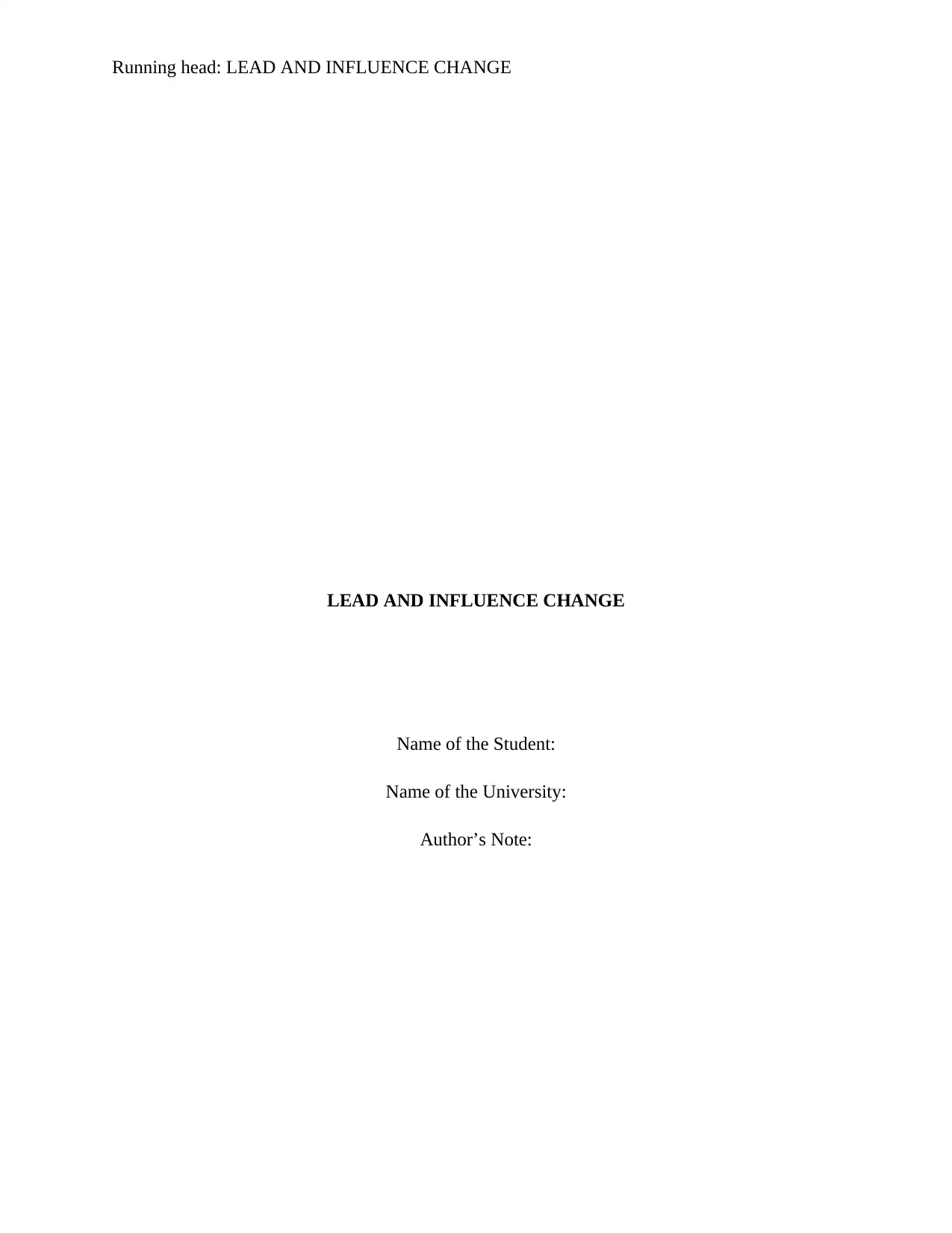
Running head: LEAD AND INFLUENCE CHANGE
LEAD AND INFLUENCE CHANGE
Name of the Student:
Name of the University:
Author’s Note:
LEAD AND INFLUENCE CHANGE
Name of the Student:
Name of the University:
Author’s Note:
Paraphrase This Document
Need a fresh take? Get an instant paraphrase of this document with our AI Paraphraser
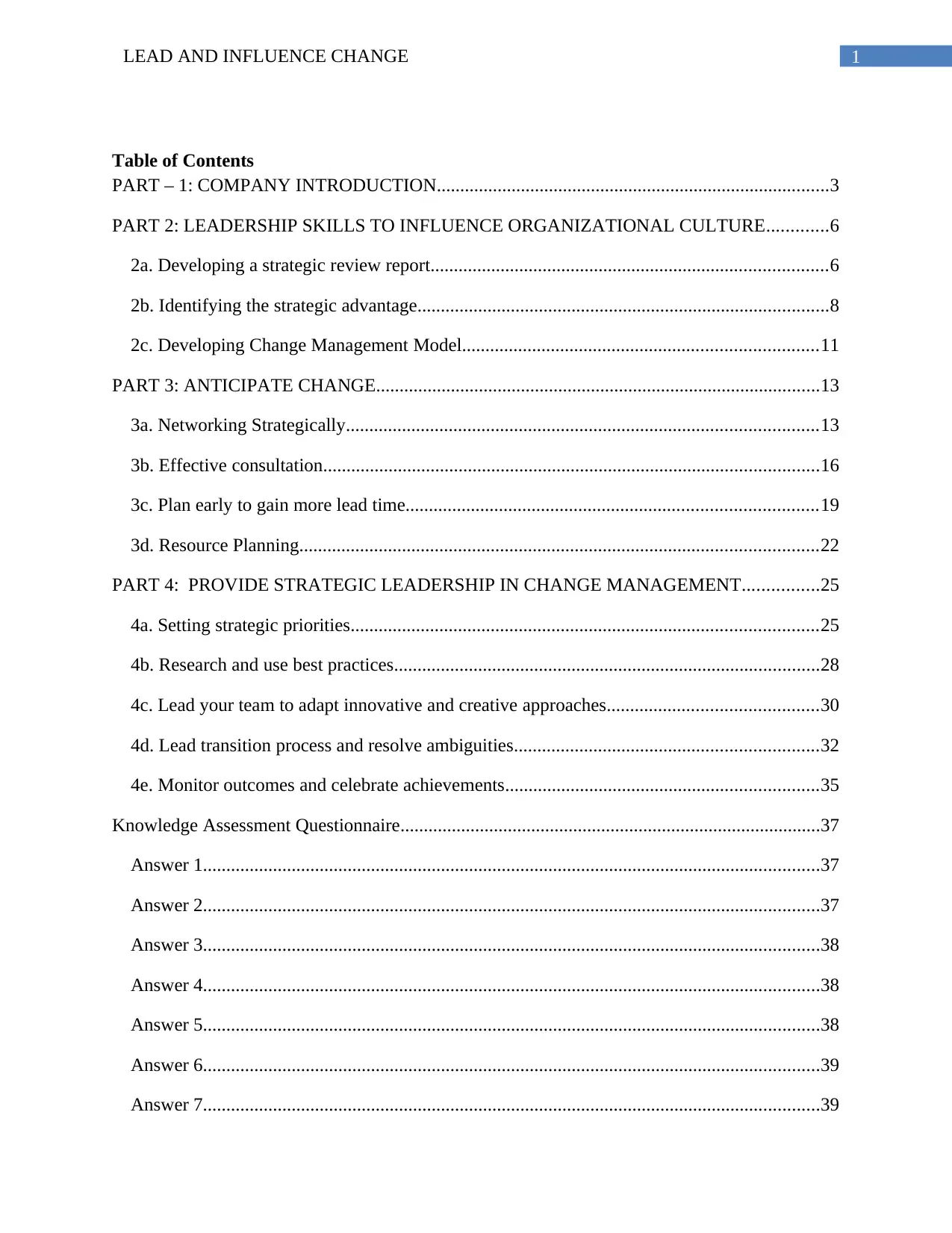
1LEAD AND INFLUENCE CHANGE
Table of Contents
PART – 1: COMPANY INTRODUCTION....................................................................................3
PART 2: LEADERSHIP SKILLS TO INFLUENCE ORGANIZATIONAL CULTURE.............6
2a. Developing a strategic review report.....................................................................................6
2b. Identifying the strategic advantage........................................................................................8
2c. Developing Change Management Model............................................................................11
PART 3: ANTICIPATE CHANGE...............................................................................................13
3a. Networking Strategically.....................................................................................................13
3b. Effective consultation..........................................................................................................16
3c. Plan early to gain more lead time........................................................................................19
3d. Resource Planning...............................................................................................................22
PART 4: PROVIDE STRATEGIC LEADERSHIP IN CHANGE MANAGEMENT................25
4a. Setting strategic priorities....................................................................................................25
4b. Research and use best practices...........................................................................................28
4c. Lead your team to adapt innovative and creative approaches.............................................30
4d. Lead transition process and resolve ambiguities.................................................................32
4e. Monitor outcomes and celebrate achievements...................................................................35
Knowledge Assessment Questionnaire..........................................................................................37
Answer 1....................................................................................................................................37
Answer 2....................................................................................................................................37
Answer 3....................................................................................................................................38
Answer 4....................................................................................................................................38
Answer 5....................................................................................................................................38
Answer 6....................................................................................................................................39
Answer 7....................................................................................................................................39
Table of Contents
PART – 1: COMPANY INTRODUCTION....................................................................................3
PART 2: LEADERSHIP SKILLS TO INFLUENCE ORGANIZATIONAL CULTURE.............6
2a. Developing a strategic review report.....................................................................................6
2b. Identifying the strategic advantage........................................................................................8
2c. Developing Change Management Model............................................................................11
PART 3: ANTICIPATE CHANGE...............................................................................................13
3a. Networking Strategically.....................................................................................................13
3b. Effective consultation..........................................................................................................16
3c. Plan early to gain more lead time........................................................................................19
3d. Resource Planning...............................................................................................................22
PART 4: PROVIDE STRATEGIC LEADERSHIP IN CHANGE MANAGEMENT................25
4a. Setting strategic priorities....................................................................................................25
4b. Research and use best practices...........................................................................................28
4c. Lead your team to adapt innovative and creative approaches.............................................30
4d. Lead transition process and resolve ambiguities.................................................................32
4e. Monitor outcomes and celebrate achievements...................................................................35
Knowledge Assessment Questionnaire..........................................................................................37
Answer 1....................................................................................................................................37
Answer 2....................................................................................................................................37
Answer 3....................................................................................................................................38
Answer 4....................................................................................................................................38
Answer 5....................................................................................................................................38
Answer 6....................................................................................................................................39
Answer 7....................................................................................................................................39
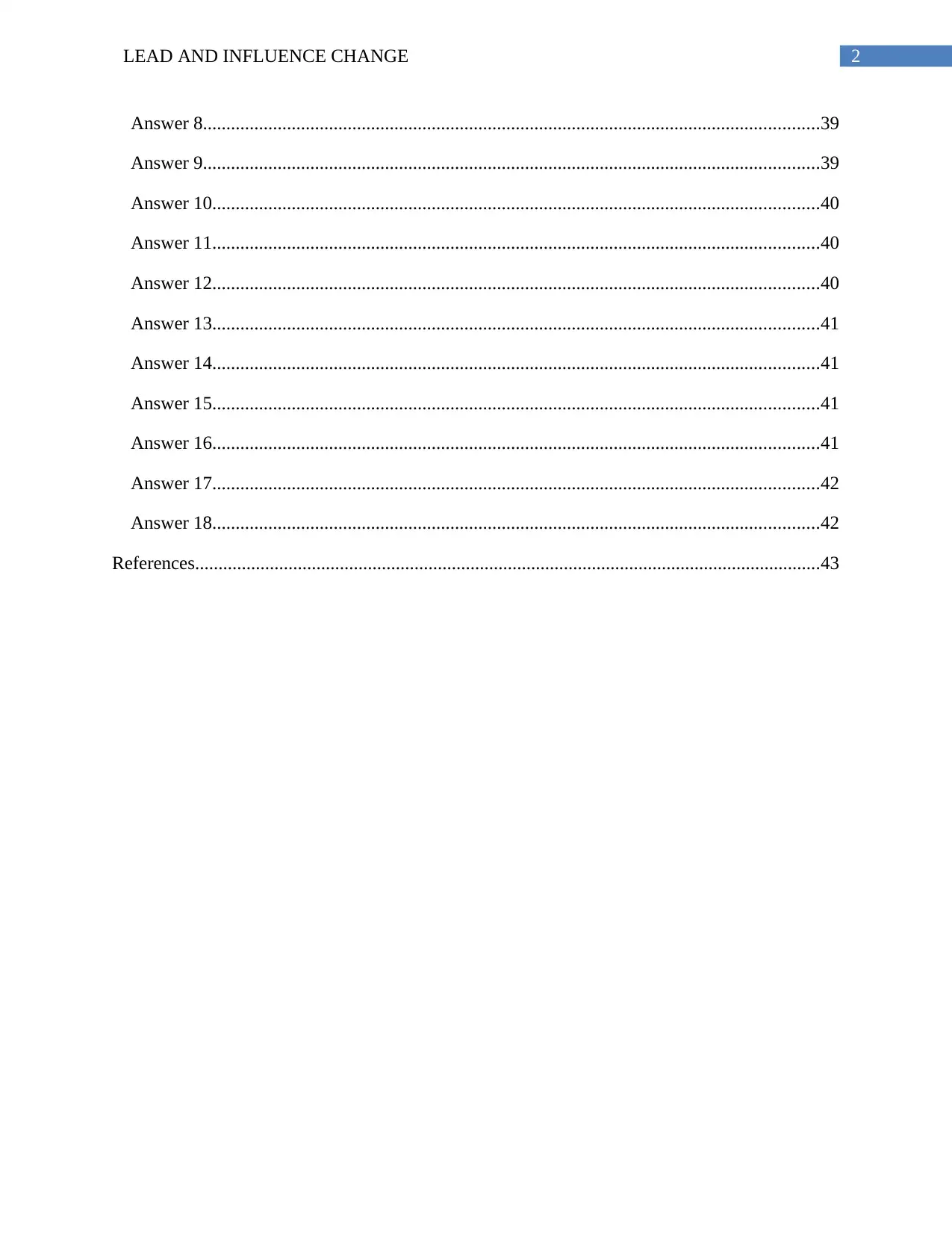
2LEAD AND INFLUENCE CHANGE
Answer 8....................................................................................................................................39
Answer 9....................................................................................................................................39
Answer 10..................................................................................................................................40
Answer 11..................................................................................................................................40
Answer 12..................................................................................................................................40
Answer 13..................................................................................................................................41
Answer 14..................................................................................................................................41
Answer 15..................................................................................................................................41
Answer 16..................................................................................................................................41
Answer 17..................................................................................................................................42
Answer 18..................................................................................................................................42
References......................................................................................................................................43
Answer 8....................................................................................................................................39
Answer 9....................................................................................................................................39
Answer 10..................................................................................................................................40
Answer 11..................................................................................................................................40
Answer 12..................................................................................................................................40
Answer 13..................................................................................................................................41
Answer 14..................................................................................................................................41
Answer 15..................................................................................................................................41
Answer 16..................................................................................................................................41
Answer 17..................................................................................................................................42
Answer 18..................................................................................................................................42
References......................................................................................................................................43
⊘ This is a preview!⊘
Do you want full access?
Subscribe today to unlock all pages.

Trusted by 1+ million students worldwide
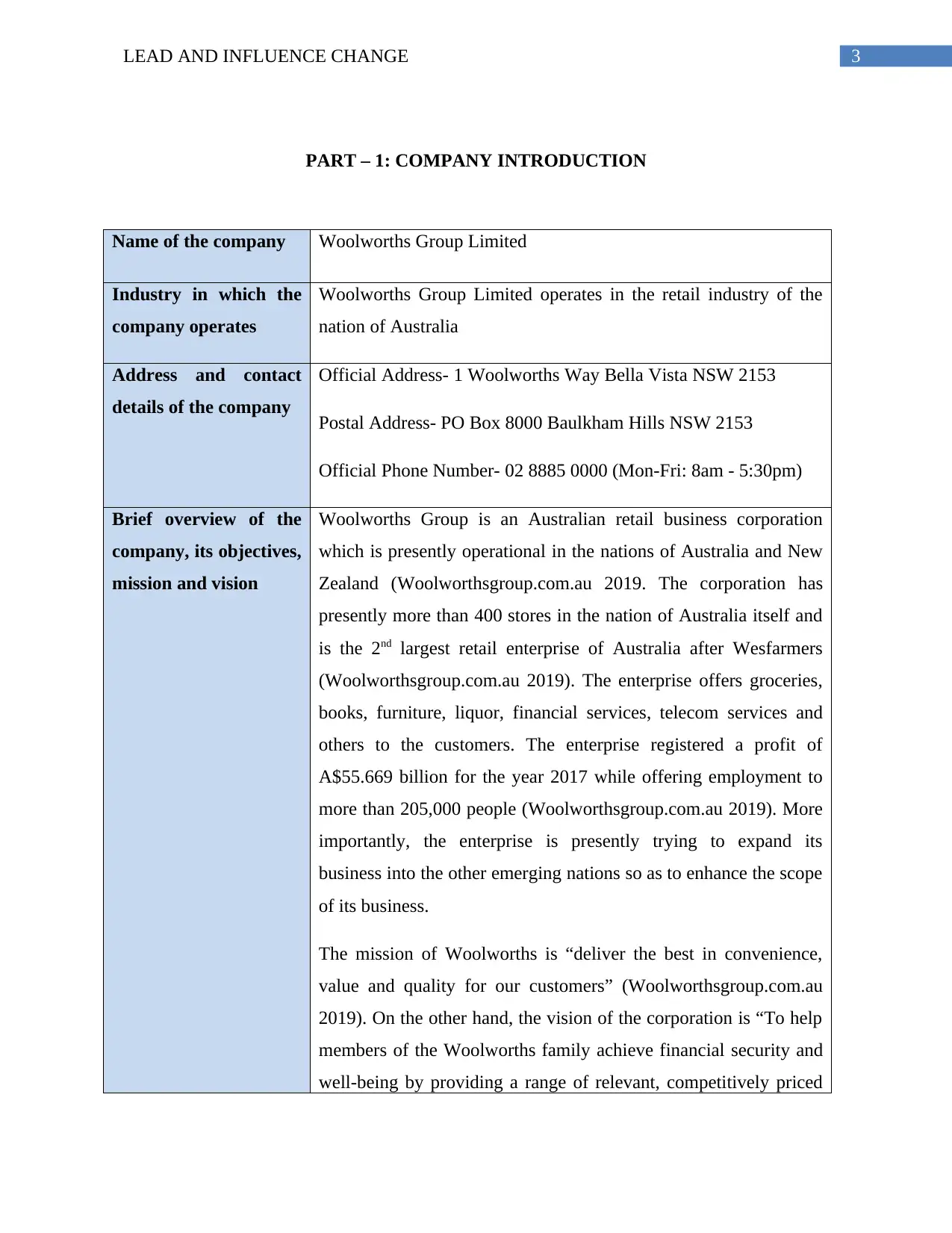
3LEAD AND INFLUENCE CHANGE
PART – 1: COMPANY INTRODUCTION
Name of the company Woolworths Group Limited
Industry in which the
company operates
Woolworths Group Limited operates in the retail industry of the
nation of Australia
Address and contact
details of the company
Official Address- 1 Woolworths Way Bella Vista NSW 2153
Postal Address- PO Box 8000 Baulkham Hills NSW 2153
Official Phone Number- 02 8885 0000 (Mon-Fri: 8am - 5:30pm)
Brief overview of the
company, its objectives,
mission and vision
Woolworths Group is an Australian retail business corporation
which is presently operational in the nations of Australia and New
Zealand (Woolworthsgroup.com.au 2019. The corporation has
presently more than 400 stores in the nation of Australia itself and
is the 2nd largest retail enterprise of Australia after Wesfarmers
(Woolworthsgroup.com.au 2019). The enterprise offers groceries,
books, furniture, liquor, financial services, telecom services and
others to the customers. The enterprise registered a profit of
A$55.669 billion for the year 2017 while offering employment to
more than 205,000 people (Woolworthsgroup.com.au 2019). More
importantly, the enterprise is presently trying to expand its
business into the other emerging nations so as to enhance the scope
of its business.
The mission of Woolworths is “deliver the best in convenience,
value and quality for our customers” (Woolworthsgroup.com.au
2019). On the other hand, the vision of the corporation is “To help
members of the Woolworths family achieve financial security and
well-being by providing a range of relevant, competitively priced
PART – 1: COMPANY INTRODUCTION
Name of the company Woolworths Group Limited
Industry in which the
company operates
Woolworths Group Limited operates in the retail industry of the
nation of Australia
Address and contact
details of the company
Official Address- 1 Woolworths Way Bella Vista NSW 2153
Postal Address- PO Box 8000 Baulkham Hills NSW 2153
Official Phone Number- 02 8885 0000 (Mon-Fri: 8am - 5:30pm)
Brief overview of the
company, its objectives,
mission and vision
Woolworths Group is an Australian retail business corporation
which is presently operational in the nations of Australia and New
Zealand (Woolworthsgroup.com.au 2019. The corporation has
presently more than 400 stores in the nation of Australia itself and
is the 2nd largest retail enterprise of Australia after Wesfarmers
(Woolworthsgroup.com.au 2019). The enterprise offers groceries,
books, furniture, liquor, financial services, telecom services and
others to the customers. The enterprise registered a profit of
A$55.669 billion for the year 2017 while offering employment to
more than 205,000 people (Woolworthsgroup.com.au 2019). More
importantly, the enterprise is presently trying to expand its
business into the other emerging nations so as to enhance the scope
of its business.
The mission of Woolworths is “deliver the best in convenience,
value and quality for our customers” (Woolworthsgroup.com.au
2019). On the other hand, the vision of the corporation is “To help
members of the Woolworths family achieve financial security and
well-being by providing a range of relevant, competitively priced
Paraphrase This Document
Need a fresh take? Get an instant paraphrase of this document with our AI Paraphraser
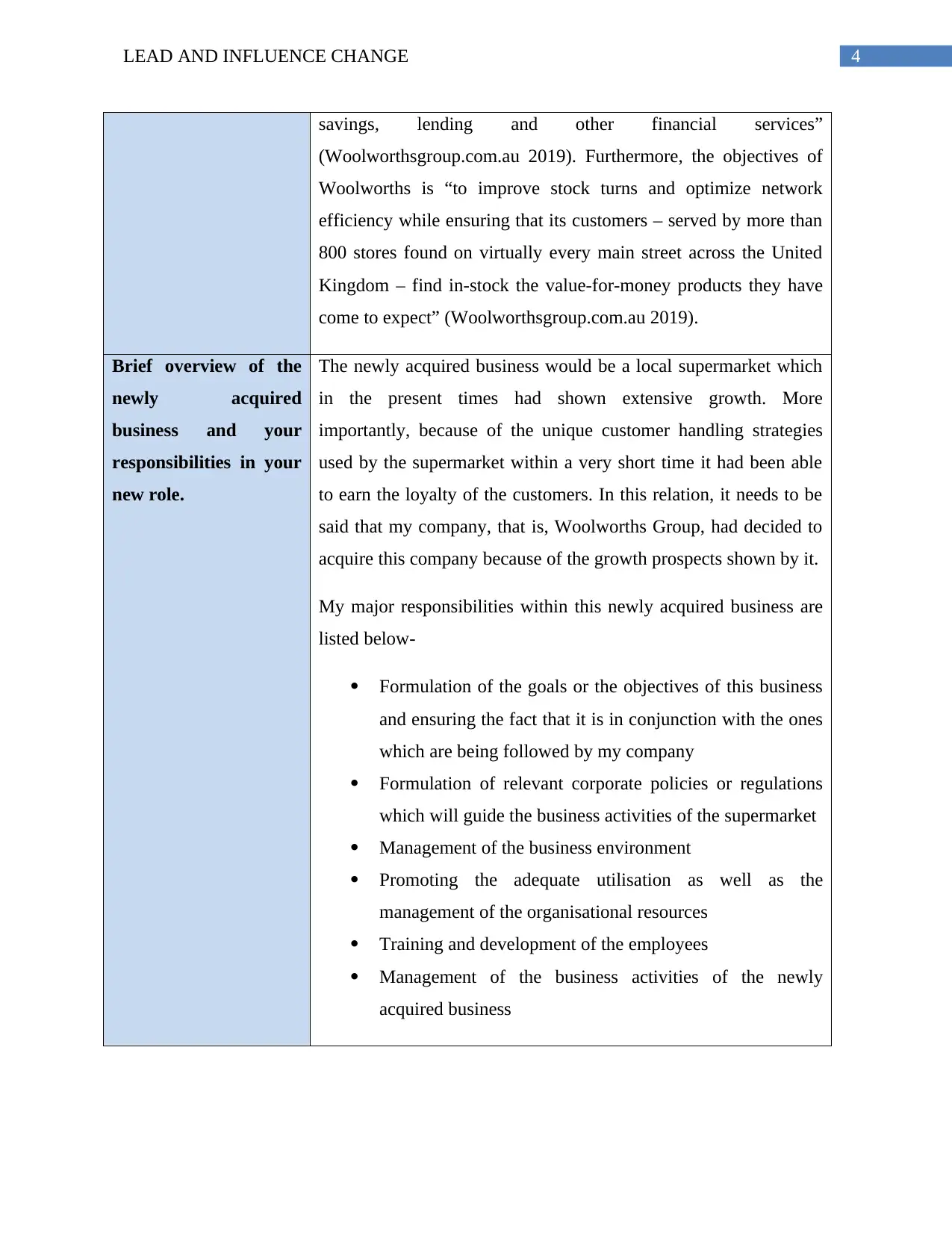
4LEAD AND INFLUENCE CHANGE
savings, lending and other financial services”
(Woolworthsgroup.com.au 2019). Furthermore, the objectives of
Woolworths is “to improve stock turns and optimize network
efficiency while ensuring that its customers – served by more than
800 stores found on virtually every main street across the United
Kingdom – find in-stock the value-for-money products they have
come to expect” (Woolworthsgroup.com.au 2019).
Brief overview of the
newly acquired
business and your
responsibilities in your
new role.
The newly acquired business would be a local supermarket which
in the present times had shown extensive growth. More
importantly, because of the unique customer handling strategies
used by the supermarket within a very short time it had been able
to earn the loyalty of the customers. In this relation, it needs to be
said that my company, that is, Woolworths Group, had decided to
acquire this company because of the growth prospects shown by it.
My major responsibilities within this newly acquired business are
listed below-
Formulation of the goals or the objectives of this business
and ensuring the fact that it is in conjunction with the ones
which are being followed by my company
Formulation of relevant corporate policies or regulations
which will guide the business activities of the supermarket
Management of the business environment
Promoting the adequate utilisation as well as the
management of the organisational resources
Training and development of the employees
Management of the business activities of the newly
acquired business
savings, lending and other financial services”
(Woolworthsgroup.com.au 2019). Furthermore, the objectives of
Woolworths is “to improve stock turns and optimize network
efficiency while ensuring that its customers – served by more than
800 stores found on virtually every main street across the United
Kingdom – find in-stock the value-for-money products they have
come to expect” (Woolworthsgroup.com.au 2019).
Brief overview of the
newly acquired
business and your
responsibilities in your
new role.
The newly acquired business would be a local supermarket which
in the present times had shown extensive growth. More
importantly, because of the unique customer handling strategies
used by the supermarket within a very short time it had been able
to earn the loyalty of the customers. In this relation, it needs to be
said that my company, that is, Woolworths Group, had decided to
acquire this company because of the growth prospects shown by it.
My major responsibilities within this newly acquired business are
listed below-
Formulation of the goals or the objectives of this business
and ensuring the fact that it is in conjunction with the ones
which are being followed by my company
Formulation of relevant corporate policies or regulations
which will guide the business activities of the supermarket
Management of the business environment
Promoting the adequate utilisation as well as the
management of the organisational resources
Training and development of the employees
Management of the business activities of the newly
acquired business
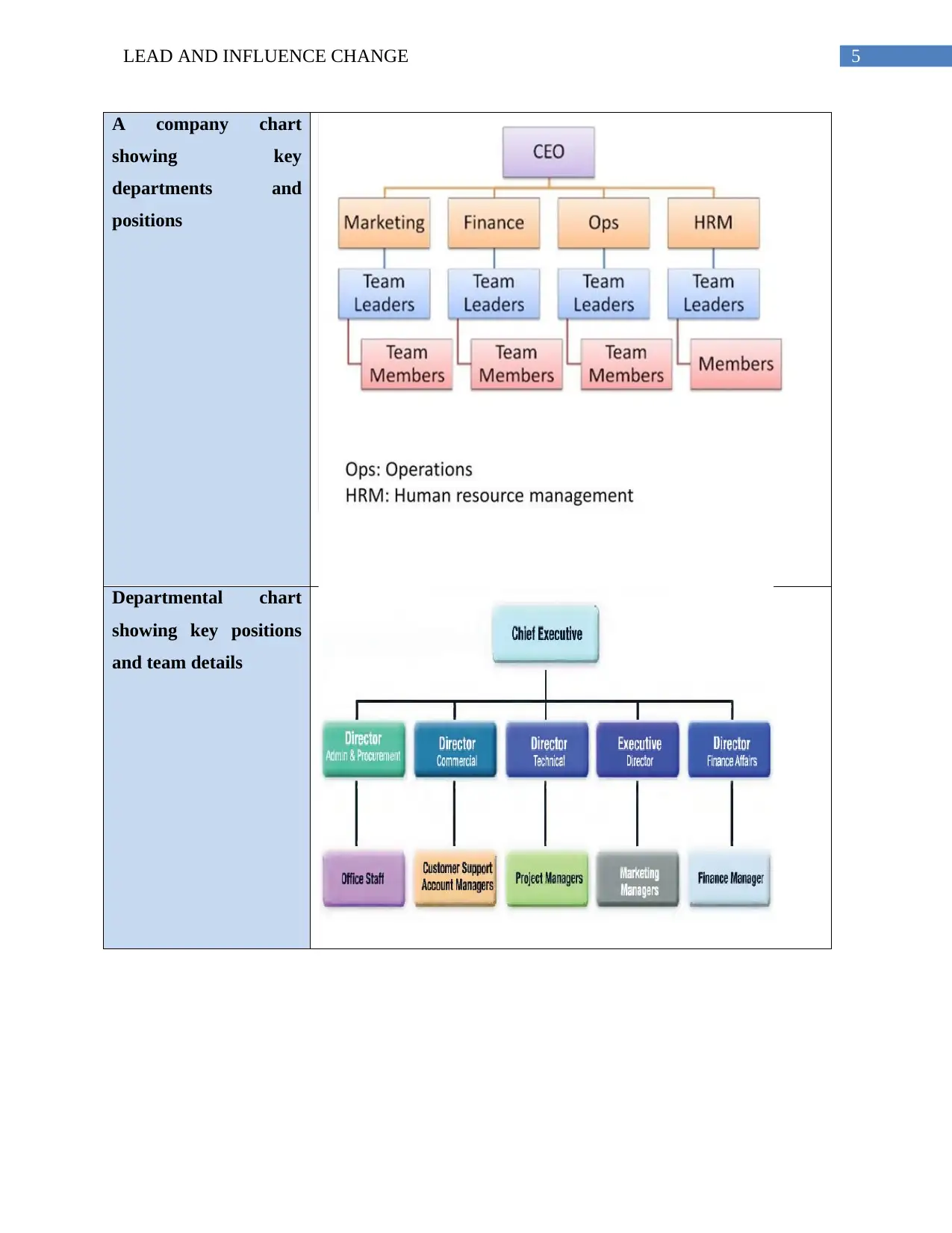
5LEAD AND INFLUENCE CHANGE
A company chart
showing key
departments and
positions
Departmental chart
showing key positions
and team details
A company chart
showing key
departments and
positions
Departmental chart
showing key positions
and team details
⊘ This is a preview!⊘
Do you want full access?
Subscribe today to unlock all pages.

Trusted by 1+ million students worldwide
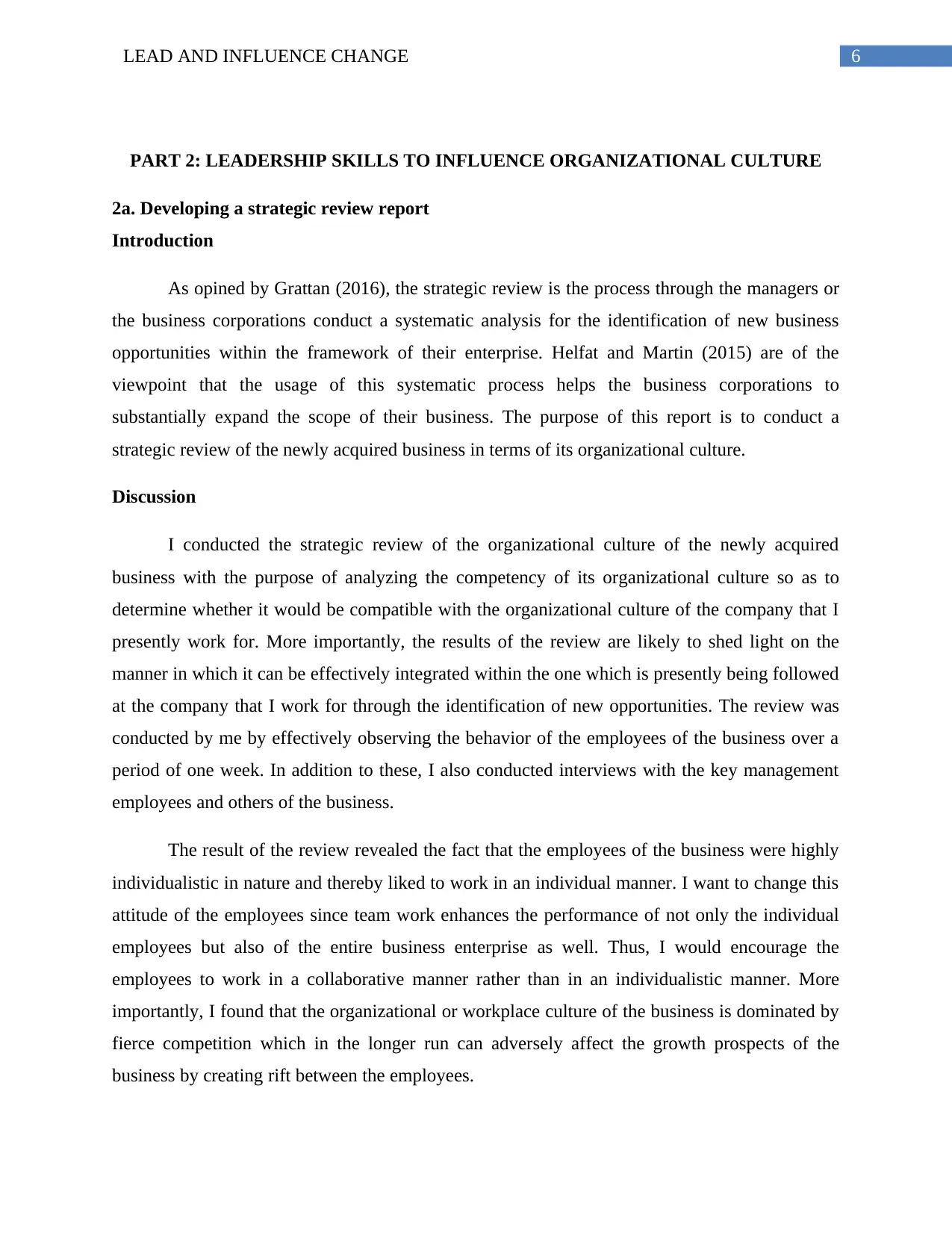
6LEAD AND INFLUENCE CHANGE
PART 2: LEADERSHIP SKILLS TO INFLUENCE ORGANIZATIONAL CULTURE
2a. Developing a strategic review report
Introduction
As opined by Grattan (2016), the strategic review is the process through the managers or
the business corporations conduct a systematic analysis for the identification of new business
opportunities within the framework of their enterprise. Helfat and Martin (2015) are of the
viewpoint that the usage of this systematic process helps the business corporations to
substantially expand the scope of their business. The purpose of this report is to conduct a
strategic review of the newly acquired business in terms of its organizational culture.
Discussion
I conducted the strategic review of the organizational culture of the newly acquired
business with the purpose of analyzing the competency of its organizational culture so as to
determine whether it would be compatible with the organizational culture of the company that I
presently work for. More importantly, the results of the review are likely to shed light on the
manner in which it can be effectively integrated within the one which is presently being followed
at the company that I work for through the identification of new opportunities. The review was
conducted by me by effectively observing the behavior of the employees of the business over a
period of one week. In addition to these, I also conducted interviews with the key management
employees and others of the business.
The result of the review revealed the fact that the employees of the business were highly
individualistic in nature and thereby liked to work in an individual manner. I want to change this
attitude of the employees since team work enhances the performance of not only the individual
employees but also of the entire business enterprise as well. Thus, I would encourage the
employees to work in a collaborative manner rather than in an individualistic manner. More
importantly, I found that the organizational or workplace culture of the business is dominated by
fierce competition which in the longer run can adversely affect the growth prospects of the
business by creating rift between the employees.
PART 2: LEADERSHIP SKILLS TO INFLUENCE ORGANIZATIONAL CULTURE
2a. Developing a strategic review report
Introduction
As opined by Grattan (2016), the strategic review is the process through the managers or
the business corporations conduct a systematic analysis for the identification of new business
opportunities within the framework of their enterprise. Helfat and Martin (2015) are of the
viewpoint that the usage of this systematic process helps the business corporations to
substantially expand the scope of their business. The purpose of this report is to conduct a
strategic review of the newly acquired business in terms of its organizational culture.
Discussion
I conducted the strategic review of the organizational culture of the newly acquired
business with the purpose of analyzing the competency of its organizational culture so as to
determine whether it would be compatible with the organizational culture of the company that I
presently work for. More importantly, the results of the review are likely to shed light on the
manner in which it can be effectively integrated within the one which is presently being followed
at the company that I work for through the identification of new opportunities. The review was
conducted by me by effectively observing the behavior of the employees of the business over a
period of one week. In addition to these, I also conducted interviews with the key management
employees and others of the business.
The result of the review revealed the fact that the employees of the business were highly
individualistic in nature and thereby liked to work in an individual manner. I want to change this
attitude of the employees since team work enhances the performance of not only the individual
employees but also of the entire business enterprise as well. Thus, I would encourage the
employees to work in a collaborative manner rather than in an individualistic manner. More
importantly, I found that the organizational or workplace culture of the business is dominated by
fierce competition which in the longer run can adversely affect the growth prospects of the
business by creating rift between the employees.
Paraphrase This Document
Need a fresh take? Get an instant paraphrase of this document with our AI Paraphraser
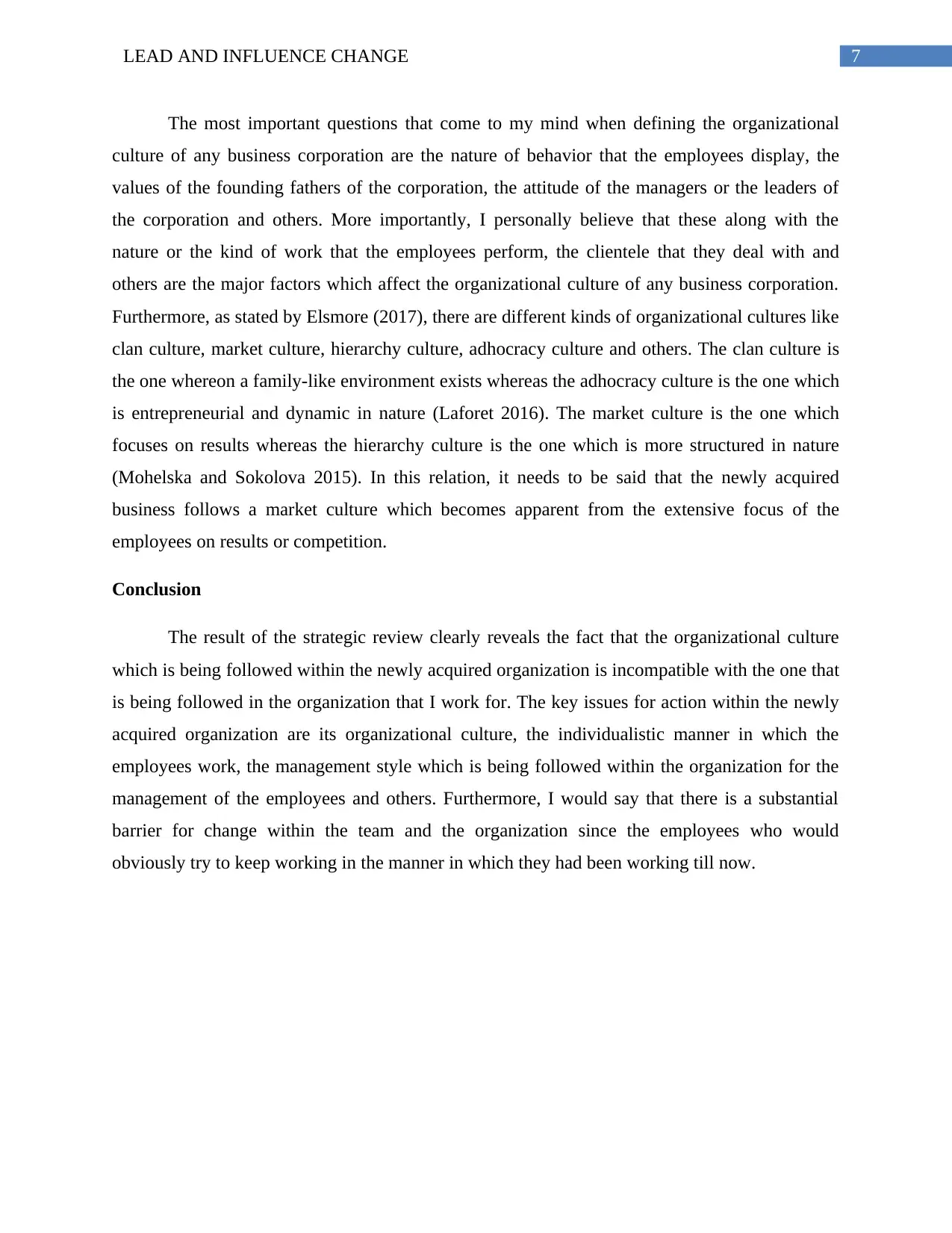
7LEAD AND INFLUENCE CHANGE
The most important questions that come to my mind when defining the organizational
culture of any business corporation are the nature of behavior that the employees display, the
values of the founding fathers of the corporation, the attitude of the managers or the leaders of
the corporation and others. More importantly, I personally believe that these along with the
nature or the kind of work that the employees perform, the clientele that they deal with and
others are the major factors which affect the organizational culture of any business corporation.
Furthermore, as stated by Elsmore (2017), there are different kinds of organizational cultures like
clan culture, market culture, hierarchy culture, adhocracy culture and others. The clan culture is
the one whereon a family-like environment exists whereas the adhocracy culture is the one which
is entrepreneurial and dynamic in nature (Laforet 2016). The market culture is the one which
focuses on results whereas the hierarchy culture is the one which is more structured in nature
(Mohelska and Sokolova 2015). In this relation, it needs to be said that the newly acquired
business follows a market culture which becomes apparent from the extensive focus of the
employees on results or competition.
Conclusion
The result of the strategic review clearly reveals the fact that the organizational culture
which is being followed within the newly acquired organization is incompatible with the one that
is being followed in the organization that I work for. The key issues for action within the newly
acquired organization are its organizational culture, the individualistic manner in which the
employees work, the management style which is being followed within the organization for the
management of the employees and others. Furthermore, I would say that there is a substantial
barrier for change within the team and the organization since the employees who would
obviously try to keep working in the manner in which they had been working till now.
The most important questions that come to my mind when defining the organizational
culture of any business corporation are the nature of behavior that the employees display, the
values of the founding fathers of the corporation, the attitude of the managers or the leaders of
the corporation and others. More importantly, I personally believe that these along with the
nature or the kind of work that the employees perform, the clientele that they deal with and
others are the major factors which affect the organizational culture of any business corporation.
Furthermore, as stated by Elsmore (2017), there are different kinds of organizational cultures like
clan culture, market culture, hierarchy culture, adhocracy culture and others. The clan culture is
the one whereon a family-like environment exists whereas the adhocracy culture is the one which
is entrepreneurial and dynamic in nature (Laforet 2016). The market culture is the one which
focuses on results whereas the hierarchy culture is the one which is more structured in nature
(Mohelska and Sokolova 2015). In this relation, it needs to be said that the newly acquired
business follows a market culture which becomes apparent from the extensive focus of the
employees on results or competition.
Conclusion
The result of the strategic review clearly reveals the fact that the organizational culture
which is being followed within the newly acquired organization is incompatible with the one that
is being followed in the organization that I work for. The key issues for action within the newly
acquired organization are its organizational culture, the individualistic manner in which the
employees work, the management style which is being followed within the organization for the
management of the employees and others. Furthermore, I would say that there is a substantial
barrier for change within the team and the organization since the employees who would
obviously try to keep working in the manner in which they had been working till now.
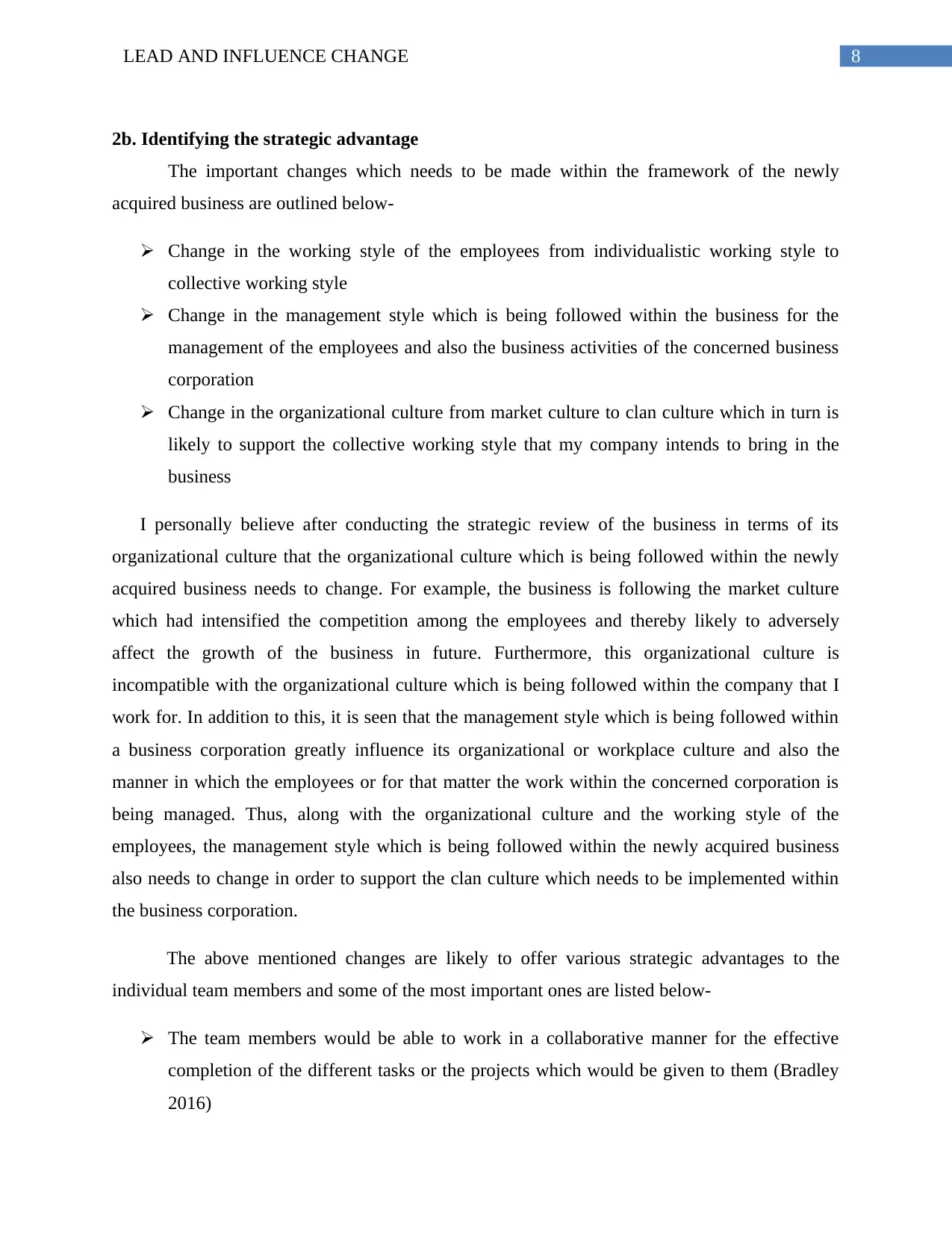
8LEAD AND INFLUENCE CHANGE
2b. Identifying the strategic advantage
The important changes which needs to be made within the framework of the newly
acquired business are outlined below-
Change in the working style of the employees from individualistic working style to
collective working style
Change in the management style which is being followed within the business for the
management of the employees and also the business activities of the concerned business
corporation
Change in the organizational culture from market culture to clan culture which in turn is
likely to support the collective working style that my company intends to bring in the
business
I personally believe after conducting the strategic review of the business in terms of its
organizational culture that the organizational culture which is being followed within the newly
acquired business needs to change. For example, the business is following the market culture
which had intensified the competition among the employees and thereby likely to adversely
affect the growth of the business in future. Furthermore, this organizational culture is
incompatible with the organizational culture which is being followed within the company that I
work for. In addition to this, it is seen that the management style which is being followed within
a business corporation greatly influence its organizational or workplace culture and also the
manner in which the employees or for that matter the work within the concerned corporation is
being managed. Thus, along with the organizational culture and the working style of the
employees, the management style which is being followed within the newly acquired business
also needs to change in order to support the clan culture which needs to be implemented within
the business corporation.
The above mentioned changes are likely to offer various strategic advantages to the
individual team members and some of the most important ones are listed below-
The team members would be able to work in a collaborative manner for the effective
completion of the different tasks or the projects which would be given to them (Bradley
2016)
2b. Identifying the strategic advantage
The important changes which needs to be made within the framework of the newly
acquired business are outlined below-
Change in the working style of the employees from individualistic working style to
collective working style
Change in the management style which is being followed within the business for the
management of the employees and also the business activities of the concerned business
corporation
Change in the organizational culture from market culture to clan culture which in turn is
likely to support the collective working style that my company intends to bring in the
business
I personally believe after conducting the strategic review of the business in terms of its
organizational culture that the organizational culture which is being followed within the newly
acquired business needs to change. For example, the business is following the market culture
which had intensified the competition among the employees and thereby likely to adversely
affect the growth of the business in future. Furthermore, this organizational culture is
incompatible with the organizational culture which is being followed within the company that I
work for. In addition to this, it is seen that the management style which is being followed within
a business corporation greatly influence its organizational or workplace culture and also the
manner in which the employees or for that matter the work within the concerned corporation is
being managed. Thus, along with the organizational culture and the working style of the
employees, the management style which is being followed within the newly acquired business
also needs to change in order to support the clan culture which needs to be implemented within
the business corporation.
The above mentioned changes are likely to offer various strategic advantages to the
individual team members and some of the most important ones are listed below-
The team members would be able to work in a collaborative manner for the effective
completion of the different tasks or the projects which would be given to them (Bradley
2016)
⊘ This is a preview!⊘
Do you want full access?
Subscribe today to unlock all pages.

Trusted by 1+ million students worldwide
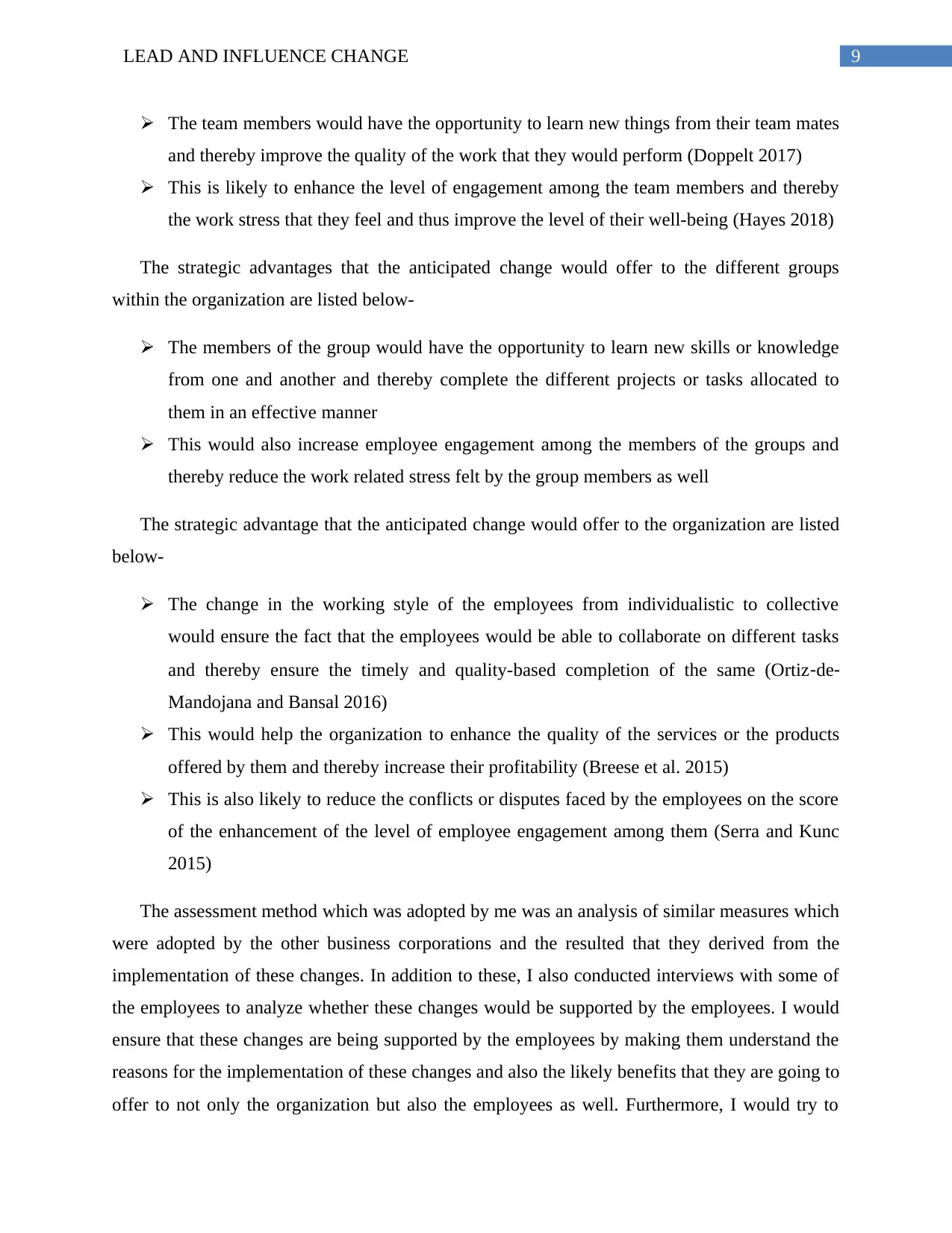
9LEAD AND INFLUENCE CHANGE
The team members would have the opportunity to learn new things from their team mates
and thereby improve the quality of the work that they would perform (Doppelt 2017)
This is likely to enhance the level of engagement among the team members and thereby
the work stress that they feel and thus improve the level of their well-being (Hayes 2018)
The strategic advantages that the anticipated change would offer to the different groups
within the organization are listed below-
The members of the group would have the opportunity to learn new skills or knowledge
from one and another and thereby complete the different projects or tasks allocated to
them in an effective manner
This would also increase employee engagement among the members of the groups and
thereby reduce the work related stress felt by the group members as well
The strategic advantage that the anticipated change would offer to the organization are listed
below-
The change in the working style of the employees from individualistic to collective
would ensure the fact that the employees would be able to collaborate on different tasks
and thereby ensure the timely and quality-based completion of the same (Ortiz‐de‐
Mandojana and Bansal 2016)
This would help the organization to enhance the quality of the services or the products
offered by them and thereby increase their profitability (Breese et al. 2015)
This is also likely to reduce the conflicts or disputes faced by the employees on the score
of the enhancement of the level of employee engagement among them (Serra and Kunc
2015)
The assessment method which was adopted by me was an analysis of similar measures which
were adopted by the other business corporations and the resulted that they derived from the
implementation of these changes. In addition to these, I also conducted interviews with some of
the employees to analyze whether these changes would be supported by the employees. I would
ensure that these changes are being supported by the employees by making them understand the
reasons for the implementation of these changes and also the likely benefits that they are going to
offer to not only the organization but also the employees as well. Furthermore, I would try to
The team members would have the opportunity to learn new things from their team mates
and thereby improve the quality of the work that they would perform (Doppelt 2017)
This is likely to enhance the level of engagement among the team members and thereby
the work stress that they feel and thus improve the level of their well-being (Hayes 2018)
The strategic advantages that the anticipated change would offer to the different groups
within the organization are listed below-
The members of the group would have the opportunity to learn new skills or knowledge
from one and another and thereby complete the different projects or tasks allocated to
them in an effective manner
This would also increase employee engagement among the members of the groups and
thereby reduce the work related stress felt by the group members as well
The strategic advantage that the anticipated change would offer to the organization are listed
below-
The change in the working style of the employees from individualistic to collective
would ensure the fact that the employees would be able to collaborate on different tasks
and thereby ensure the timely and quality-based completion of the same (Ortiz‐de‐
Mandojana and Bansal 2016)
This would help the organization to enhance the quality of the services or the products
offered by them and thereby increase their profitability (Breese et al. 2015)
This is also likely to reduce the conflicts or disputes faced by the employees on the score
of the enhancement of the level of employee engagement among them (Serra and Kunc
2015)
The assessment method which was adopted by me was an analysis of similar measures which
were adopted by the other business corporations and the resulted that they derived from the
implementation of these changes. In addition to these, I also conducted interviews with some of
the employees to analyze whether these changes would be supported by the employees. I would
ensure that these changes are being supported by the employees by making them understand the
reasons for the implementation of these changes and also the likely benefits that they are going to
offer to not only the organization but also the employees as well. Furthermore, I would try to
Paraphrase This Document
Need a fresh take? Get an instant paraphrase of this document with our AI Paraphraser
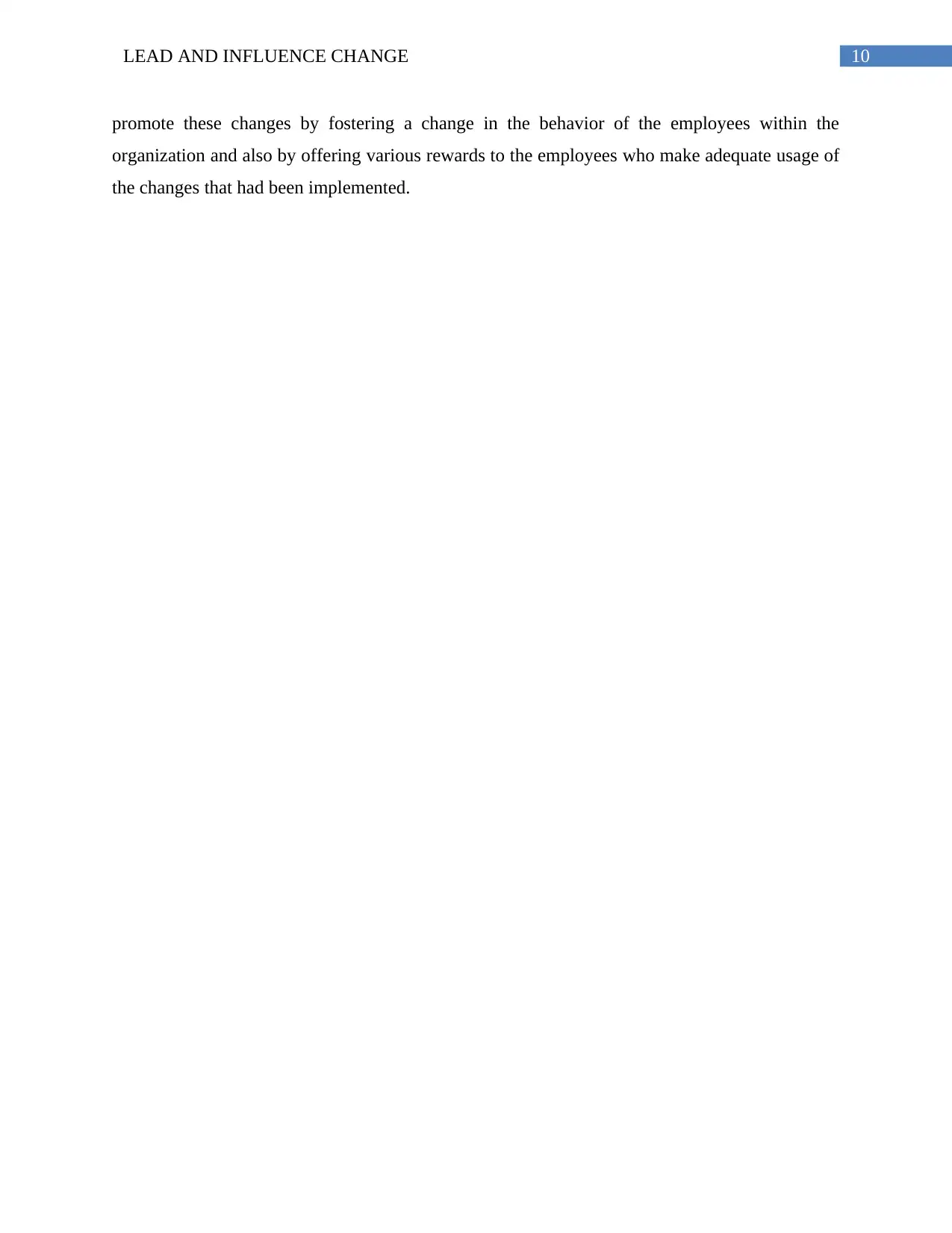
10LEAD AND INFLUENCE CHANGE
promote these changes by fostering a change in the behavior of the employees within the
organization and also by offering various rewards to the employees who make adequate usage of
the changes that had been implemented.
promote these changes by fostering a change in the behavior of the employees within the
organization and also by offering various rewards to the employees who make adequate usage of
the changes that had been implemented.
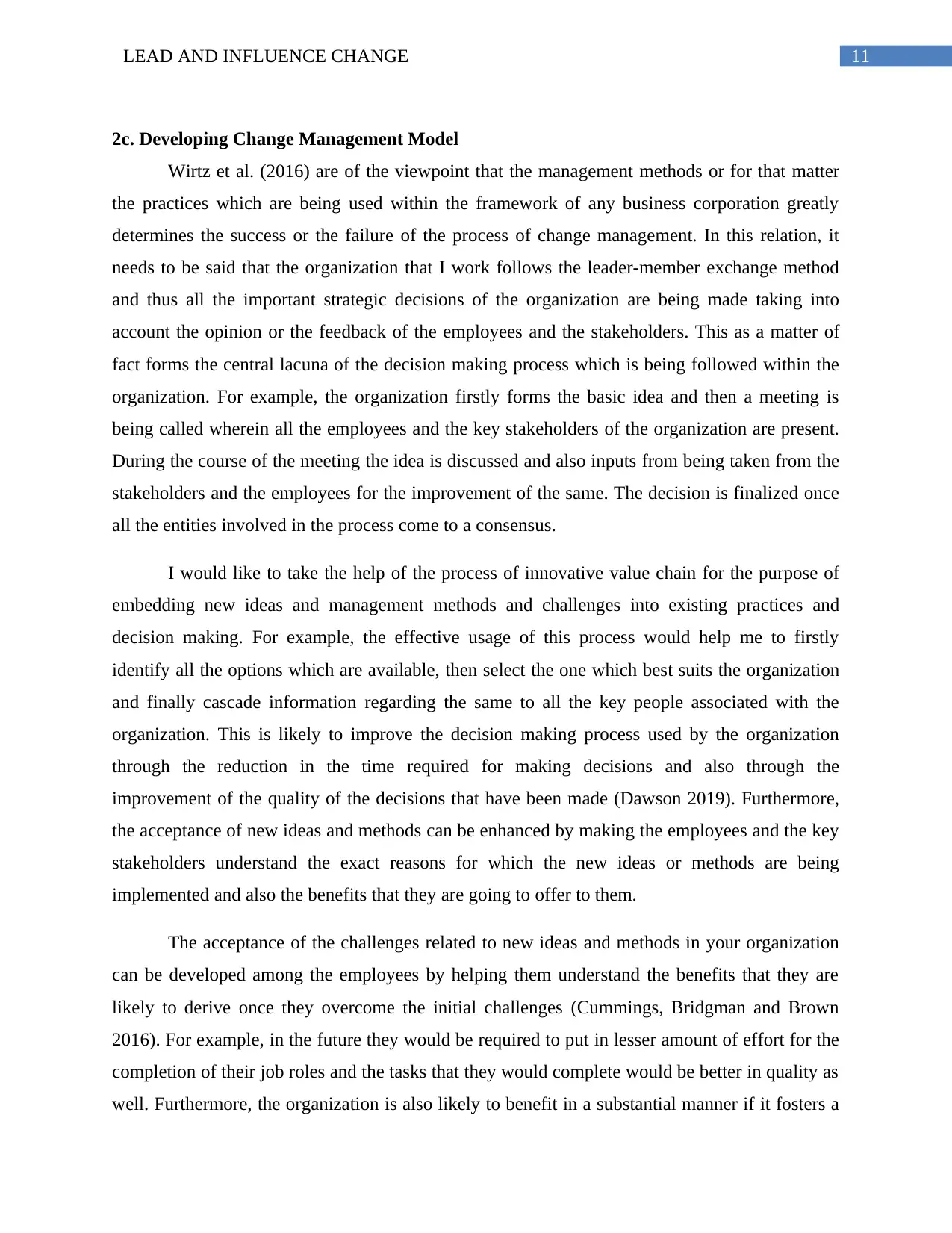
11LEAD AND INFLUENCE CHANGE
2c. Developing Change Management Model
Wirtz et al. (2016) are of the viewpoint that the management methods or for that matter
the practices which are being used within the framework of any business corporation greatly
determines the success or the failure of the process of change management. In this relation, it
needs to be said that the organization that I work follows the leader-member exchange method
and thus all the important strategic decisions of the organization are being made taking into
account the opinion or the feedback of the employees and the stakeholders. This as a matter of
fact forms the central lacuna of the decision making process which is being followed within the
organization. For example, the organization firstly forms the basic idea and then a meeting is
being called wherein all the employees and the key stakeholders of the organization are present.
During the course of the meeting the idea is discussed and also inputs from being taken from the
stakeholders and the employees for the improvement of the same. The decision is finalized once
all the entities involved in the process come to a consensus.
I would like to take the help of the process of innovative value chain for the purpose of
embedding new ideas and management methods and challenges into existing practices and
decision making. For example, the effective usage of this process would help me to firstly
identify all the options which are available, then select the one which best suits the organization
and finally cascade information regarding the same to all the key people associated with the
organization. This is likely to improve the decision making process used by the organization
through the reduction in the time required for making decisions and also through the
improvement of the quality of the decisions that have been made (Dawson 2019). Furthermore,
the acceptance of new ideas and methods can be enhanced by making the employees and the key
stakeholders understand the exact reasons for which the new ideas or methods are being
implemented and also the benefits that they are going to offer to them.
The acceptance of the challenges related to new ideas and methods in your organization
can be developed among the employees by helping them understand the benefits that they are
likely to derive once they overcome the initial challenges (Cummings, Bridgman and Brown
2016). For example, in the future they would be required to put in lesser amount of effort for the
completion of their job roles and the tasks that they would complete would be better in quality as
well. Furthermore, the organization is also likely to benefit in a substantial manner if it fosters a
2c. Developing Change Management Model
Wirtz et al. (2016) are of the viewpoint that the management methods or for that matter
the practices which are being used within the framework of any business corporation greatly
determines the success or the failure of the process of change management. In this relation, it
needs to be said that the organization that I work follows the leader-member exchange method
and thus all the important strategic decisions of the organization are being made taking into
account the opinion or the feedback of the employees and the stakeholders. This as a matter of
fact forms the central lacuna of the decision making process which is being followed within the
organization. For example, the organization firstly forms the basic idea and then a meeting is
being called wherein all the employees and the key stakeholders of the organization are present.
During the course of the meeting the idea is discussed and also inputs from being taken from the
stakeholders and the employees for the improvement of the same. The decision is finalized once
all the entities involved in the process come to a consensus.
I would like to take the help of the process of innovative value chain for the purpose of
embedding new ideas and management methods and challenges into existing practices and
decision making. For example, the effective usage of this process would help me to firstly
identify all the options which are available, then select the one which best suits the organization
and finally cascade information regarding the same to all the key people associated with the
organization. This is likely to improve the decision making process used by the organization
through the reduction in the time required for making decisions and also through the
improvement of the quality of the decisions that have been made (Dawson 2019). Furthermore,
the acceptance of new ideas and methods can be enhanced by making the employees and the key
stakeholders understand the exact reasons for which the new ideas or methods are being
implemented and also the benefits that they are going to offer to them.
The acceptance of the challenges related to new ideas and methods in your organization
can be developed among the employees by helping them understand the benefits that they are
likely to derive once they overcome the initial challenges (Cummings, Bridgman and Brown
2016). For example, in the future they would be required to put in lesser amount of effort for the
completion of their job roles and the tasks that they would complete would be better in quality as
well. Furthermore, the organization is also likely to benefit in a substantial manner if it fosters a
⊘ This is a preview!⊘
Do you want full access?
Subscribe today to unlock all pages.

Trusted by 1+ million students worldwide
1 out of 48
Related Documents
Your All-in-One AI-Powered Toolkit for Academic Success.
+13062052269
info@desklib.com
Available 24*7 on WhatsApp / Email
![[object Object]](/_next/static/media/star-bottom.7253800d.svg)
Unlock your academic potential
Copyright © 2020–2025 A2Z Services. All Rights Reserved. Developed and managed by ZUCOL.





